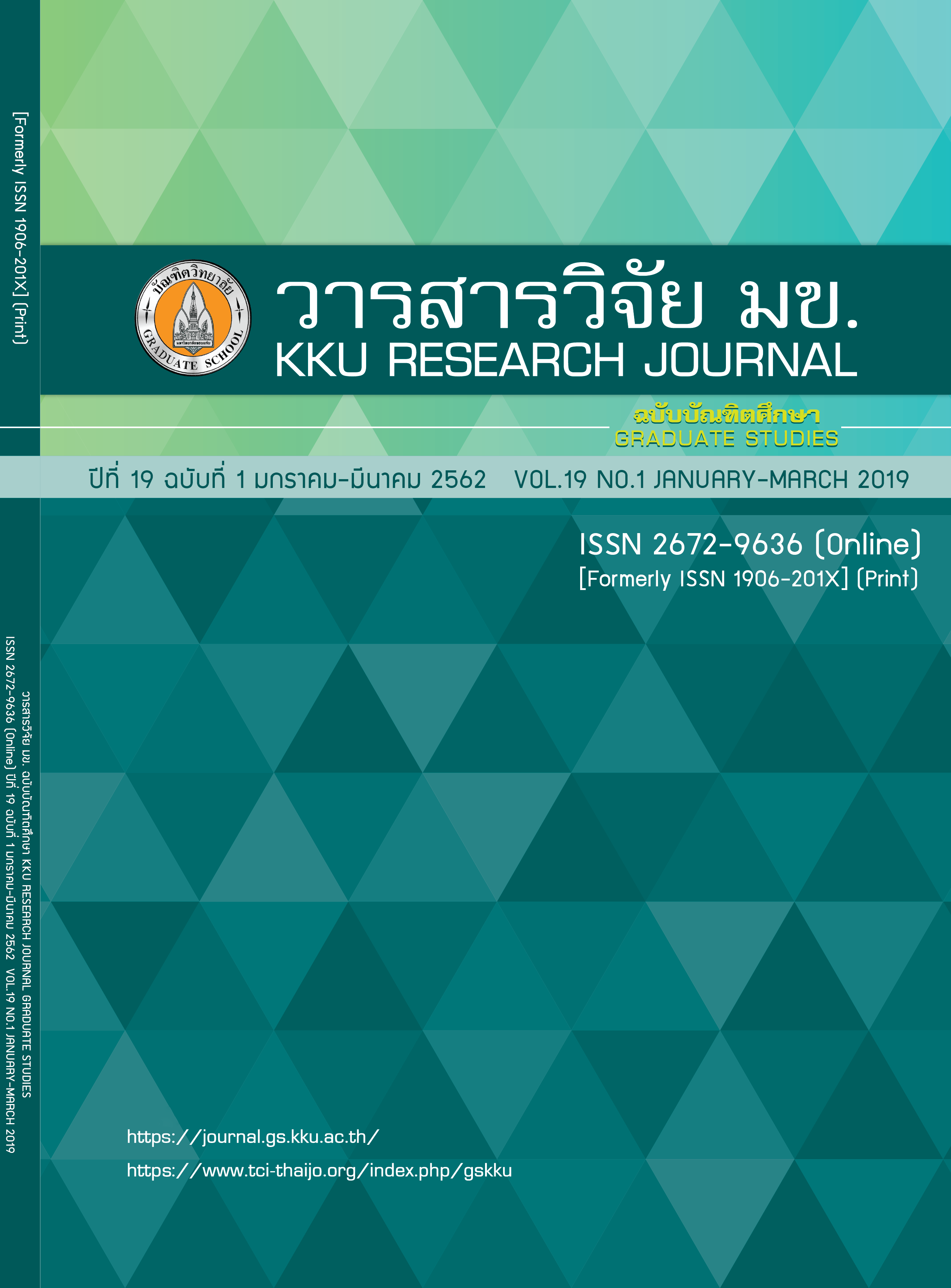การศึกษาเพื่อปรับปรุงจุดอันตรายบริเวณกลุ่มทางแยกคณะวิศวกรรมศาสตร์ มหาวิทยาลัยขอนแก่น โดยประยุกต์ใช้แบบจำลองสภาพการจราจรระดับจุลภาค
คำสำคัญ:
การปรับปรุงจุดอันตราย, จุดขัดแย้ง, การจำลองสภาพจราจรบทคัดย่อ
การศึกษานี้มีวัตถุประสงค์เพื่อเสนอและประเมินมาตรการปรับปรุงกลุ่มทางแยกบริเวณลานจอดรถคณะวิศวกรรมศาสตร์ มหาวิทยาลัยขอนแก่น โดยประยุกต์ใช้แบบจำลองการจราจรระดับจุลภาค การศึกษาสำรวจสภาพจราจรช่วงเร่งด่วนเช้า เพื่อใช้สอบเทียบแบบจำลอง และสำรวจสภาพจราจรช่วงเร่งด่วนเย็นเพื่อสอบทวนความถูกต้องของแบบจำลอง โดยแบบจำลองที่สร้างขึ้นผ่านการสอบเทียบและทวนสอบความถูกต้องตามเกณฑ์มาตรฐานสากล จากนั้น ประยุกต์ใช้แบบจำลองเพื่อประเมินมาตรการต่างๆ ที่นำเสนอ ซึ่งประกอบด้วย 1) ปรับปรุงเป็นทางสี่แยกติดตั้งป้ายเตือน 2) ปรับปรุงเป็นสี่แยกสัญญาณไฟจราจร และ 3) ปรับปรุงเป็น วงเวียน ผลการประเมินประสิทธิภาพการให้บริการและความปลอดภัยของมาตรการ พบว่า มาตรการปรับปรุงเป็นวงเวียนเหมาะสมที่สุด โดยความยาวแถวคอยลดลง 50% ความล่าช้าเฉลี่ยลดลง 44% และจุดขัดแย้งลดลง 41% เมื่อเทียบกับสถานการณ์ปัจจุบัน ผลการวิเคราะห์ความอ่อนไหวเมื่อปริมาณจราจรเพิ่มขึ้นจากปัจจุบัน 30% พบว่ามาตรการปรับปรุงเป็นวงเวียนยังคงเหมาะสมที่สุด โดยความยาวแถวคอย ลดลง 24% ความล่าช้าลดลง 13% จุดขัดแย้งลดลง 51% เมื่อเทียบกับสถานการณ์ปัจจุบัน
References
2. Sustainable Infrastructure Research and Development Center (SIRDC), Khon Kaen University. 2012. complete report Project study and preparation of baseline emissions from Transportation sector in the pilot provinces and education guidelines for promotion. Greenhouse Gas Emission Reduction Activities, Department of Civil Engineering Faculty of Engineering Khon Kaen University Thai.
3. James Cox, OD Matrix Creator With Route Choice Program, Department for Transport, Energy & Infrastructure, South Australia. 2014.
4. Gopal R, Patil, Jayant P. Sangole ‘Behavior of two-wheelers at limited priority uncontrolled T-intersections’, Accident Analysis & Prevention, 2015.
5. Akhilesh Kumar Maurya, Harsh J, Amin, Arvind Kumar, ‘Estimation of Critical Gap for Through Movement at Four Leg Uncontrolled Intersection’ Transportation Research Procedia 17: 2016. 203–212.
6. Thepkaew A, Kornpraseart N, Phichayapunt P. ‘Analysis of Driving Behavior of Vehicles Entering Roundabouts under Mixed Traffic Conditions in Urban Area.’ , Proceedings of The 20th National Convention on Civil Engineering 8-10 July 2015, Chonburi, Thai.
7. A guide to documenting vissim-based microscopic traffic simulation models., Research Report, Agreement T4118, Task 09, Traffic Simulation Lab.
8. Vincenzo G, Vaiana R, Iuele T. ‘Comparison between Simulated and Experimental Crossing Speed Profiles on Roundabout with Different Geometric Features’, Procedia - Social and Behavioral Sciences, 111: 2014.
9. Wisconsin DOT, Microsimulation Guidelines http://www.wisdot.info/microsimulation/index.php?title= Model_Calibration: Wisconsin Department of Transportation. 2014.
10. Webster and cobbe, Traffic signals, Transportation and Road Research Laboratory (TRRL), England. 1966.
11. Kanittpong K. Guide to Design a Roundabout to Enhance Safety at intersection., Thailand Accident Research Center, Asian Institute of Technology. 2015. Thai.
12. Federal Highway Administration (FHWA) ‘Surrogate Safety Assessment Model (SSAM), Research, Development, and Technology, Turner-Fairbank Highway Research Center, US. Department of Transportation, 2008.


